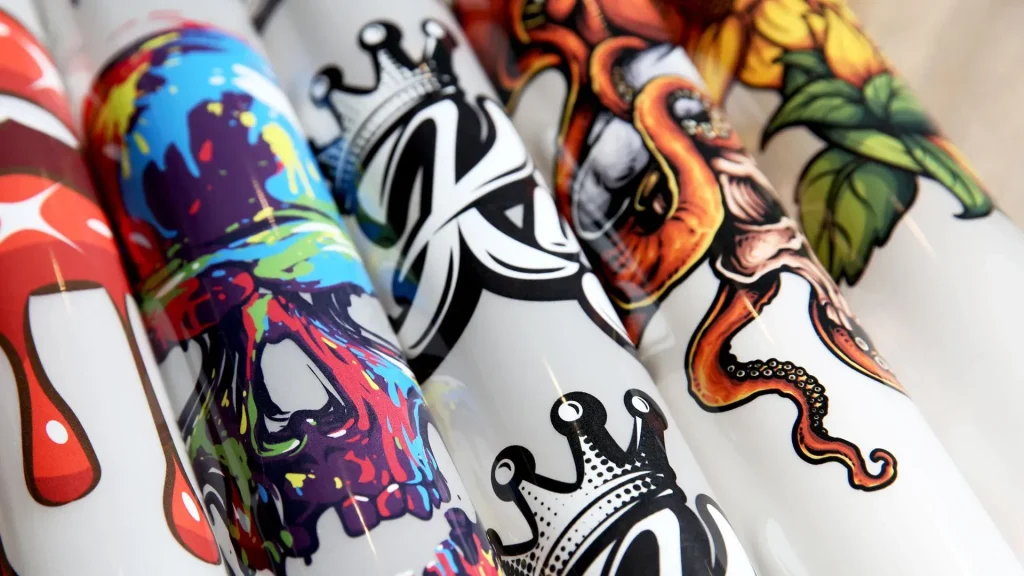DTF transfers, or Direct to Film transfers, have emerged as a revolutionary technique within the printing industry, paving the way for high-quality and customizable designs that meet the demands of today’s consumers. This innovative method employs advanced printing technologies to create eye-catching designs with exceptional durability, making it a favorite for custom apparel and merchandise. By leveraging DTF printing techniques, businesses can produce vibrant prints on a variety of textiles with incredible detail and color depth. Whether for small batch orders or complex designs, DTF transfer applications are versatile and efficient, providing endless possibilities for customization. In this comprehensive guide, we will explore best practices for DTF printing and discuss the exciting future trends that promise to enhance sustainability and innovation in this dynamic field.
The practice of Direct to Film printing is revolutionizing how businesses approach garment personalization and promotional products. Using advanced DTF printing methods, creators can transfer intricate designs onto diverse substrates, ensuring high fidelity and lasting results. This technology is particularly advantageous for those looking to produce small quantities of custom items while maintaining exceptional quality. As the demand for personalized and unique products continues to rise, the adaptability of DTF transfer techniques makes them a top choice for creative industries. Join us as we delve deeper into the benefits and cutting-edge advancements surrounding DTF technology, as well as practical tips to maximize its effectiveness.
Understanding the Basics of DTF Transfers
DTF transfers, or Direct to Film transfers, have revolutionized the printing industry by providing a high-quality alternative to traditional methods. In essence, the process involves printing designs onto a special film that is subsequently heat-transferred onto various fabrics. This technique uses eco-solvent or pigment inks, which ensure vibrant colors and superior durability. One of the standout features of DTF is its ability to replicate intricate designs with remarkable accuracy, making it an excellent choice for custom apparel and personalized merchandise.
Unlike conventional printing methods such as screen printing, DTF is particularly advantageous for small batches and complex imagery. This flexibility caters to the rising demand for personalized fashion items and allows businesses to meet specific customer preferences without incurring the high costs often associated with larger order quantities. As businesses strive for uniqueness in a competitive market, understanding DTF transfers becomes essential for those looking to offer tailored solutions.
Exploring DTF Printing Techniques
Delving into DTF printing techniques, it’s essential to grasp the intricacies of the process to achieve the best results. The first step involves selecting the right DTF printer, which plays a pivotal role in producing high-resolution images. Utilizing specialized inks formulated for DTF can significantly enhance adhesion to a variety of fabrics, resulting in vibrant, long-lasting prints. Moreover, the equipment used, such as pretreatment machines and heat presses, influences the quality of the end product.
Further optimization can be achieved by experimenting with various film types, as not all transfer films yield the same results. High-quality films reduce potential transfer issues and improve the overall finish of the print. By mastering these DTF printing techniques, businesses can produce eye-catching custom designs that satisfy their customers while maintaining efficient production workflows.
Innovative Applications of DTF Transfers
The versatility of DTF transfers has led to a plethora of innovative applications across different industries. In the fashion sector, DTF technology has enabled brands to produce unique custom apparel that reflects individual styles. This method is perfect for on-demand printing, allowing businesses to swiftly provide tailored garments that resonate with consumers seeking personalization in their fashion choices.
Additionally, DTF transfers have gained traction in the promotional products sphere. Companies can utilize this printing method to create vibrant promotional merchandise, including tote bags, caps, and shirts, which serve as effective marketing tools. The capacity to produce high-quality, short-run items means that businesses can explore niche markets without the risk of overcommitting to larger stock orders.
Best Practices for Successful DTF Printing
To ensure successful outcomes with DTF printing, implementing best practices is paramount. One crucial step is the pre-treatment of fabrics, which enhances the adhesive properties of the transfer. By doing so, you ensure that the DTF transfer adheres flawlessly, preventing issues such as peeling or fading over time. This pre-treatment process can significantly affect the longevity and appearance of the final print.
Moreover, selecting the right transfer film is vital. Investing in high-quality films minimizes transfer challenges and enhances your printing results, leading to more professional-grade outputs. Additionally, optimizing heat press settings according to manufacturer guidelines is essential. Perfecting temperature, pressure, and duration will maximize transfer quality, ultimately meeting customer expectations for durability and vibrancy.
Sustainable Practices in DTF Printing
As sustainability becomes a driving force in various industries, DTF printing is not left behind. The adoption of eco-friendly practices, such as the use of sustainable inks and recyclable materials, is a growing trend among printing companies. By utilizing low-impact inks, DTF transfers can significantly reduce the environmental footprint associated with traditional printing methods, making it an attractive option for eco-conscious brands.
Furthermore, businesses are also considering the source of their materials and the overall impact of their production processes. Integrating eco-friendly strategies within DTF printing helps companies align with consumer expectations while contributing positively to environmental sustainability. This shift not only promotes responsible manufacturing practices but also attracts a new demographic of customers who prioritize sustainability when making purchasing decisions.
Future Trends Influencing DTF Printing
Looking ahead, the future of DTF printing holds exciting trends that promise to shape its evolution. One prominent trend is the increasing demand for customization, as consumers gravitate towards unique, personalized products. DTF technology aligns perfectly with this demand, allowing businesses to offer on-demand printing services that cater to individual customer preferences, thus enhancing customer satisfaction and loyalty.
Moreover, advancements in workflow integration and automation are expected to streamline DTF printing processes further. As new software and equipment emerge, businesses will be able to enhance efficiency and productivity, minimizing lead times for high volume orders. By staying attuned to these trends, companies can position themselves at the forefront of DTF technology and capitalize on the expanding opportunities within the printing industry.
Frequently Asked Questions
What are DTF Transfers in printing?
DTF Transfers, or Direct to Film printing, is a method where designs are printed onto a special film using eco-solvent or pigment inks. This film is then heat-pressed onto garments, resulting in high-quality, durable prints that are vivid and detailed. It’s particularly effective for small batches and complex designs, making it ideal for custom apparel.
How do DTF printing techniques improve the print quality?
DTF printing techniques enhance print quality by utilizing high-performance inks that bond well with various fabric types, such as cotton and polyester blends. These inks not only provide vibrant colors but also ensure lasting durability, making DTF transfers suitable for fashion garments and promotional products.
What are some common applications for DTF Transfers?
DTF transfers are widely used for custom apparel, promotional items like totes and hats, and for short-run production. Their versatility allows businesses to create eye-catching products tailored to specific customer needs, without the extensive costs associated with traditional printing methods.
What best practices should I follow for DTF printing?
To ensure successful DTF transfers, follow best practices such as pre-treating fabrics for better adhesion, selecting high-quality transfer films, and optimizing heat press settings according to manufacturer guidelines. Proper preparation is key to achieving vibrant and long-lasting prints.
How is sustainable DTF printing being developed?
Sustainable DTF printing is emerging as printers begin to adopt eco-friendly inks and materials. As environmental consciousness grows, the industry is innovating with more sustainable practices to reduce waste and promote responsible production methods, aligning with consumer demand for environmentally friendly products.
What future trends can we expect in DTF Transfer technology?
Future trends in DTF Transfer technology include increased sustainability with eco-conscious inks, a rise in demand for customization as consumers seek personalized products, and further enhancements in workflow integration that will automate processes, thereby improving efficiency and reducing production times.
| Key Point | Description |
|---|---|
| What are DTF Transfers? | DTF transfers involve printing designs onto a special film to be transferred onto garments using heat and pressure. The method ensures high-quality prints that are durable and detailed. |
| Recent Developments in DTF Technology | Advancements include improved inks for better adhesion, and automation in workflows which enhances efficiency and production volumes. |
| Applications of DTF Transfers | DTF is widely used for custom apparel, promotional products, and short runs, making it ideal for small orders and personalized merchandise. |
| Best Practices for DTF Printing | These include pre-treating fabrics, choosing the right quality film, and optimizing heat press settings for superior transfer quality. |
| Future Trends in DTF Printing | Sustainability and increased customization are key trends shaping the future of DTF, along with enhanced integration into existing workflows. |
Summary
DTF Transfers represent a revolutionary advancement in the printing sector, offering the ability to produce high-quality, customized designs efficiently. This method stands out due to its versatility in handling complex designs, making it ideal for modern printing demands. As businesses continue to adapt to the fast-changing market trends, embracing DTF transfers can significantly elevate their printing game, allowing for more personalized and sustainable product offerings.



